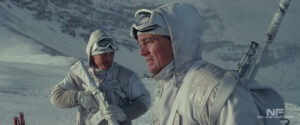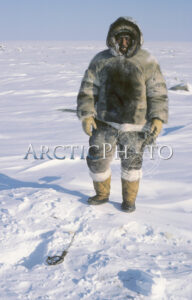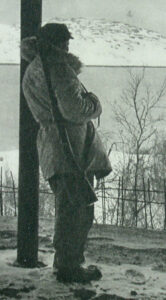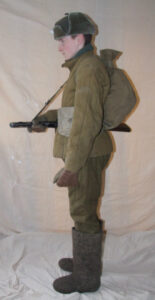
For the past couple of days, for some reason I have been thinking about winter gear.
What is the best equipment to have if you have to operate in the snow like the final level of the movie Inception?
In that movie, the “good guys” wear pure white cold weather gear, but in the real world that is not too practical.
During the invasion of Russia, the German army issued a number of items of winter clothing in white.
Troops naturally tended to wear these warm items all the time and very soon the white got dirty and lost all its camouflage performance.
The correct approach was to make warm clothing and primary camouflage separate and issue thin snowshirts, helmet covers or oversuits that could be worn only when needed and easily washed and dried when dirty.
Last night, I watched the old black and white movie “Armored Command” which featured American soldiers in WW2 operating in the snow. No one in this movie attempts to use snow camouflage.
This got me thinking on the topic of snow gear again.

The first people to consider when it comes to cold weather survival are the Inuit.
They brave the Artic in a parka and trousers of caribou skin.
According to an excellent museum exhibit I saw in Berlin (or more probably, Copenhagen) these garments are made from a double layer of furred hide, the outer layer with the fur outward and the inner fur in and are worn over the bare skin.
The exhibition also had some embroidered seal skin g-strings that were apparently the only undergarment worn in winter and sometimes the only thing worn while relaxing in the “warmth” of a shelter.
In sub-zero conditions, the challenge is often to keep your garments dry and avoid them becoming soaked with condensing perspiration.
I imagine Inuit winter clothing is fairly permeable and being relatively thin ensures that the dew point occurs outside the garments.
I have used Buffalo Double P clothing that I suspect works on a similar principle. This consists of a layer of fibre pile (artificial fur) with an outer layer of pertex, which is windproof but quick drying and permeable.
Buffalo recommend that their items be worn with the fibre pile next to the bare skin so that it can wick perspiration away to escape through the pertex before it can condense.

The Russians are the obvious military to think about when it comes to sub-zero military operations, but if you know your history you will know that the Finns taught them a few hard lessons about winter warfare.
Checking one of the few sources I had handy on Finnish military uniforms in the 1940s indicated that each Finnish soldier was issued with a sheepskin outfit for winter operations.
Like most armies of this time period, the uniform worn underneath was made from wool. I have little experience wearing sheepskin, but I suspect that it will behave rather like the Inuit clothing.

The archetypical Russian soldier’s winter clothing is the telogreika or padded jacket, often worn with matching padded trousers.
Apparently the filling was cotton batting or cotton wool.
If this is true, and not a “Wiki-fact” I would expect these garment to become pretty cold and uncomfortable if it is allowed to get wet.
The telogreika was originally intended to be worn under the greatcoat but ended up being worn on its own, particularly when a long greatcoat would be too encumbering.
The Russian greatcoat was often carried rolled up and what most people assume to be a blanket roll being worn by Russian soldiers was in fact the greatcoat. Russian greatcoats had hook and eye fastenings instead of buttons, which seems unusual but if you think about it was probably much easier to use if you are wearing thick mittens or gloves.
That will have to do for today’s blog. I will cover more specific topics later.